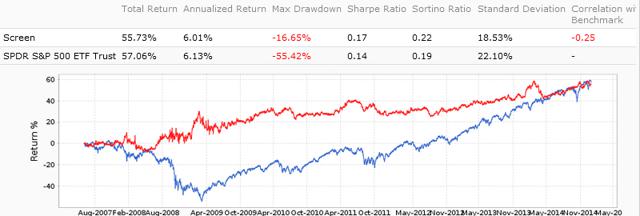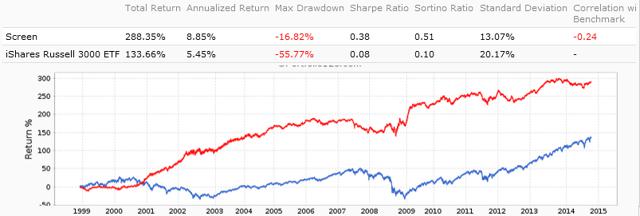Scalper1 News

 Summary For whom is Market Neutral investing. Making the short side safe. Two simple examples. Questions to solve for a real portfolio. An investment is market-neutral if it seeks to avoid exposure to market risk, typically by hedging. It can use various techniques, like statistical arbitrage in pairs trading, options in delta hedging, stock picking in long/short portfolios. This article is the first one of a series dealing with implementations of the latter category. Market Neutral Investor profile Market neutral strategies are suitable for investors who think that the market is approaching a correction or a crash, and more generally for those who want to invest without caring if the market is approaching a correction or a crash. It is especially pertinent for investors who don’t trust market timing, or who want a part of their investments to be independent of timing indicators. It is also pertinent for investors who are aware that several asset classes might sink together in specific deflationary environments, making inefficient the usual models of diversification in stocks, bonds, and hard assets. More generally, market neutral strategies attract risk-averse investors looking for capital protection, smoother drawdowns and a lower volatility. At the opposite, bullish investors used to long-only investing may be frustrated by an equity market neutral portfolio, which often underperforms the benchmark in a rising market, and whose equity curve may sometimes go down for a while whereas indices are going up. Making the short side safer An equity market-neutral portfolio generally holds equal amounts in a group of long positions and a group of short positions within a stock universe. The universe can be global (the whole stock market), focused on a country and market capitalization segment (for example the S&P 500 index), or specialized in a sector or industry (for example healthcare, biotechnology,…). I am personally reluctant to sell short individual stocks, and I know that I am not alone here. If you don’t understand why some of us don’t like short selling, just Google volkswagen short squeeze 2008 . I prefer replacing the short stock group with a unique position in an index ETF (generally DIA , SPY , IWM , IWV , QQQ depending on the universe). It significantly reduces the risks. My humble opinion is that if «Market Neutral» is for risk-averse investors, it is also better to avoid risks that are not related to the market (being trapped in a short squeeze in this case). All examples hereafter make this choice. Simple implementations The next article will show that designing a stock portfolio aiming at beating a benchmark in all market conditions is more complicated than just targeting a good risk-adjusted return. In a first step, I propose to delegate the stock picking job to an actively managed ETF: the First Trust Health Care AlphaDEX Fund (NYSEARCA: FXH ). One of my old articles ( here ) gives more information about FXH and its AlphaDEX siblings. This simulation is based on a portfolio composed of FXH on the long side and SPY on the short side rebalanced in equal weight every week. The leveraging factor is 2. Transaction costs and carry costs are accounted with respective rates of 0.01% and 2%. The next chart shows the period from 6/1/2007 to 1/2/2015. The portfolio equity curve is in red, SPY in blue. (click to enlarge) The return is not very exciting, but the risk in terms of drawdown and volatility is low. In fact, it is a stock-like return and a bond-like risk. What is not visible in a backtest is that such a strategy is less sensitive to geopolitical, macroeconomic and monetary events, than a bond portfolio. For the next example, I propose a little bit more work with a self-managed quantitative model. On the long side, I select 10% of Russell 3000 companies. The list is obtained by eliminating the 1000 companies with the worst Return on Equity (trailing 12 months), then keeping the 300 with the best Price to Free Cash Flow (trailing 12 months). On the short side, I choose the iShares Russell 3000 ETF . The portfolio is leveraged with a factor 2, rebalanced at a lower frequency of 4 weeks, with a carry cost of 2% and a transaction cost of 0.01%. The next chart shows a simulation on the period from 1/2/1999 to 1/2/2015. The portfolio equity curve is in red, the benchmark IWV in blue. (click to enlarge) The return is better than in the previous example, and the volatility is even lower (on a longer period). However, it is clearly visible that this market neutral portfolio underperforms its benchmark since April 2009. It is even in mild loss in 2014 (-1.5%). This illustrates the possible frustration in bull markets for investors who don’t understand, or are not interested in the long-term vision of such a strategy. This portfolio has 300 holdings: it is manageable for a fund, not for an individual investor. In a next article, I will explain how to get a better expected performance, how to keep the holding number reasonable yet the volatility low, why I use a meta-model to guarantee some sector diversification, and the best way to implement such a portfolio in an IRA account. Market Neutral investing is also possible without leveraging nor short selling. Feel free to follow me if you don’t want to miss this. Data and charts: Portfolio123 Additional disclosure: Past performance, real or simulated, is not a guarantee for the future. Scalper1 News
Summary For whom is Market Neutral investing. Making the short side safe. Two simple examples. Questions to solve for a real portfolio. An investment is market-neutral if it seeks to avoid exposure to market risk, typically by hedging. It can use various techniques, like statistical arbitrage in pairs trading, options in delta hedging, stock picking in long/short portfolios. This article is the first one of a series dealing with implementations of the latter category. Market Neutral Investor profile Market neutral strategies are suitable for investors who think that the market is approaching a correction or a crash, and more generally for those who want to invest without caring if the market is approaching a correction or a crash. It is especially pertinent for investors who don’t trust market timing, or who want a part of their investments to be independent of timing indicators. It is also pertinent for investors who are aware that several asset classes might sink together in specific deflationary environments, making inefficient the usual models of diversification in stocks, bonds, and hard assets. More generally, market neutral strategies attract risk-averse investors looking for capital protection, smoother drawdowns and a lower volatility. At the opposite, bullish investors used to long-only investing may be frustrated by an equity market neutral portfolio, which often underperforms the benchmark in a rising market, and whose equity curve may sometimes go down for a while whereas indices are going up. Making the short side safer An equity market-neutral portfolio generally holds equal amounts in a group of long positions and a group of short positions within a stock universe. The universe can be global (the whole stock market), focused on a country and market capitalization segment (for example the S&P 500 index), or specialized in a sector or industry (for example healthcare, biotechnology,…). I am personally reluctant to sell short individual stocks, and I know that I am not alone here. If you don’t understand why some of us don’t like short selling, just Google volkswagen short squeeze 2008 . I prefer replacing the short stock group with a unique position in an index ETF (generally DIA , SPY , IWM , IWV , QQQ depending on the universe). It significantly reduces the risks. My humble opinion is that if «Market Neutral» is for risk-averse investors, it is also better to avoid risks that are not related to the market (being trapped in a short squeeze in this case). All examples hereafter make this choice. Simple implementations The next article will show that designing a stock portfolio aiming at beating a benchmark in all market conditions is more complicated than just targeting a good risk-adjusted return. In a first step, I propose to delegate the stock picking job to an actively managed ETF: the First Trust Health Care AlphaDEX Fund (NYSEARCA: FXH ). One of my old articles ( here ) gives more information about FXH and its AlphaDEX siblings. This simulation is based on a portfolio composed of FXH on the long side and SPY on the short side rebalanced in equal weight every week. The leveraging factor is 2. Transaction costs and carry costs are accounted with respective rates of 0.01% and 2%. The next chart shows the period from 6/1/2007 to 1/2/2015. The portfolio equity curve is in red, SPY in blue. (click to enlarge) The return is not very exciting, but the risk in terms of drawdown and volatility is low. In fact, it is a stock-like return and a bond-like risk. What is not visible in a backtest is that such a strategy is less sensitive to geopolitical, macroeconomic and monetary events, than a bond portfolio. For the next example, I propose a little bit more work with a self-managed quantitative model. On the long side, I select 10% of Russell 3000 companies. The list is obtained by eliminating the 1000 companies with the worst Return on Equity (trailing 12 months), then keeping the 300 with the best Price to Free Cash Flow (trailing 12 months). On the short side, I choose the iShares Russell 3000 ETF . The portfolio is leveraged with a factor 2, rebalanced at a lower frequency of 4 weeks, with a carry cost of 2% and a transaction cost of 0.01%. The next chart shows a simulation on the period from 1/2/1999 to 1/2/2015. The portfolio equity curve is in red, the benchmark IWV in blue. (click to enlarge) The return is better than in the previous example, and the volatility is even lower (on a longer period). However, it is clearly visible that this market neutral portfolio underperforms its benchmark since April 2009. It is even in mild loss in 2014 (-1.5%). This illustrates the possible frustration in bull markets for investors who don’t understand, or are not interested in the long-term vision of such a strategy. This portfolio has 300 holdings: it is manageable for a fund, not for an individual investor. In a next article, I will explain how to get a better expected performance, how to keep the holding number reasonable yet the volatility low, why I use a meta-model to guarantee some sector diversification, and the best way to implement such a portfolio in an IRA account. Market Neutral investing is also possible without leveraging nor short selling. Feel free to follow me if you don’t want to miss this. Data and charts: Portfolio123 Additional disclosure: Past performance, real or simulated, is not a guarantee for the future. Scalper1 News
Scalper1 News